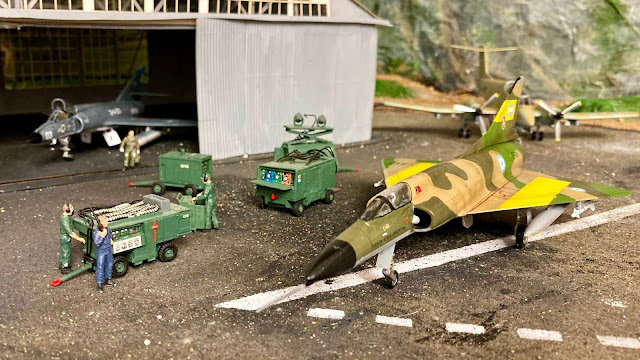I had intended to build the Mirage III at this point in my Falklands War scale modelling project but coming across the seemingly interchangeable name of Dagger used in write-ups of this time, I had to investigate further. The Dagger, I discovered, was actually the much more numerous (30:17) Israeli Nesher. The IAI (Israel Aircraft Industries) Nesher was the IAF (Israeli Air Force) version of the French Dassault Mirage 5 multirole fighter. Build from plans acquired from Dassault, before a French arms embargo severed the partnership with IAI to design the Mirage 5, it was fitted with Israeli avionics, a Martin-Baker ejection seat and the Israeli Shafrir heat-seeking missile. Between 1978 and 1980, following the retirement of the Nesher from IAF service, 39 remaining Israeli aircraft were refurbished and exported to the FAA (Argentine Air Force) who then operated it under the new name, Dagger.
 |
| PM Model IAI Nesher in the colours of FAA Dagger based at Rio Grande, June 1982 |
During the 1982 Falklands War, supported on the ground by IAI technicians, Daggers were deployed to the southern naval airbase of Río Grande, Tierra del Fuego, and an airfield in Puerto San Julián. Despite the lack of an aerial refuelling capability and the considerable distance to their targets, which gave them only 5 minutes combat time over the Falklands, the Dagger conducted 153 sorties against both ground and naval targets over the 45 days of combat operations. The primary role of the Dagger and Mirage III was to protect the Douglas A-4 Skyhawk strike force from the patrolling SHAR (British Sea Harriers). This was achieved by deploying at high altitude, drawing the SHAR away from the strike force and then, using their superior speed, out run the pursuers to return to the safety of their base on the Argentine mainland.
 | |
| Dagger C-432 stationed at San Julián, now on display at the Museo Nacional de Aeronáutica, Argentina |
 |
| PM Model's 1:72 Scale Model Kit of the IAI Nesher in the colours of the FAA Dagger |
My IAI Nesher 1:72 scale model kit, from the lesser known Turkish company PM Model, was probably one of the simplest and least detailed builds I've encountered. Rather than completing it in the IAF colours provided, I used a set of Xtradecal Falklands War decals for the Argentine FAA Dagger C-401 as flown by Lt Jorge Ratti. Using my new found Blu Tack skills in applying camouflage, I had a couple of attempts in producing the various shades of green and brown as used at this time, trying also not to over paint the unusual yellow markings on wing and tail.
 |
| Capt Carlos ‘Castor’ Rohde in C-415 |
The combat 'highlight' for FAA Dagger C-401, was the part it played in the last major air battle of the conflict: the attack on the Royal Navy's Rothesay-class frigate HMS Plymouth, in Falkland Sound and the strike by A4 Skyhawks on the landing ships at Fitzroy Cove, during 8 June 1982. HMS Plymouth had not been the intended target, the original mission being a combined Dagger/ Skyhawk strike to neutralise the British amphibious landings on East Falkland.
Five Grupo 6 Daggers, lead by Capt Carlos ‘Castor’ Rohde (C-415) with his wingmen, Lt José Gabari Zocco (C-417) and Lt Jorge Ratti (C-401), and Capt Amílcar ‘Mastin’ Cimatti (C-435) and Maj Carlos ‘Napo’ Martínez (C-418) tucked in behind, flew in a five pointed star formation up the western edge of Falkland Sound, in support of 5 Skyhawks. Their target were the LSLs (Landing Ship Logistics) offloading troops and supplies in Fitzroy Cove.
 |
| FAA Dagger C-401 flown by Lt Jorge Ratti against HMS Plymouth |
Out of his canopy to the left, Rohde spotted HMS Plymouth alone and exposed in the middle of the waterway. Leaving the LSLs to the Skyhawks, Rohde turned his 5 aircraft formation towards HMS Plymouth and, spreading out to attack in line-astern, the first three Daggers dived in to attack at wave-top height, with the second pair close behind.
 |
| HMS Plymouth and HMS Avenger in San Carlos Water |




No comments:
Post a Comment
Note: only a member of this blog may post a comment.